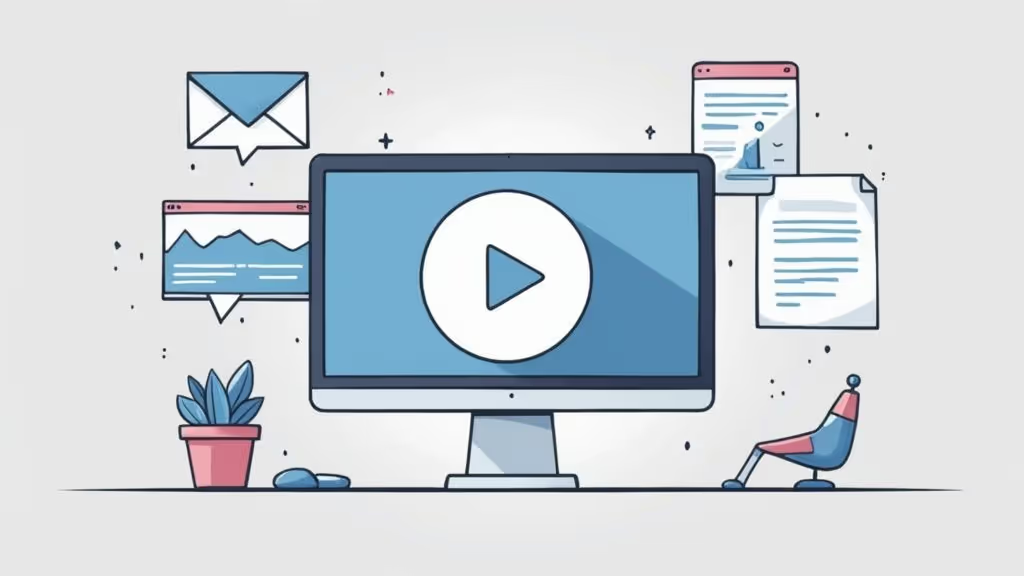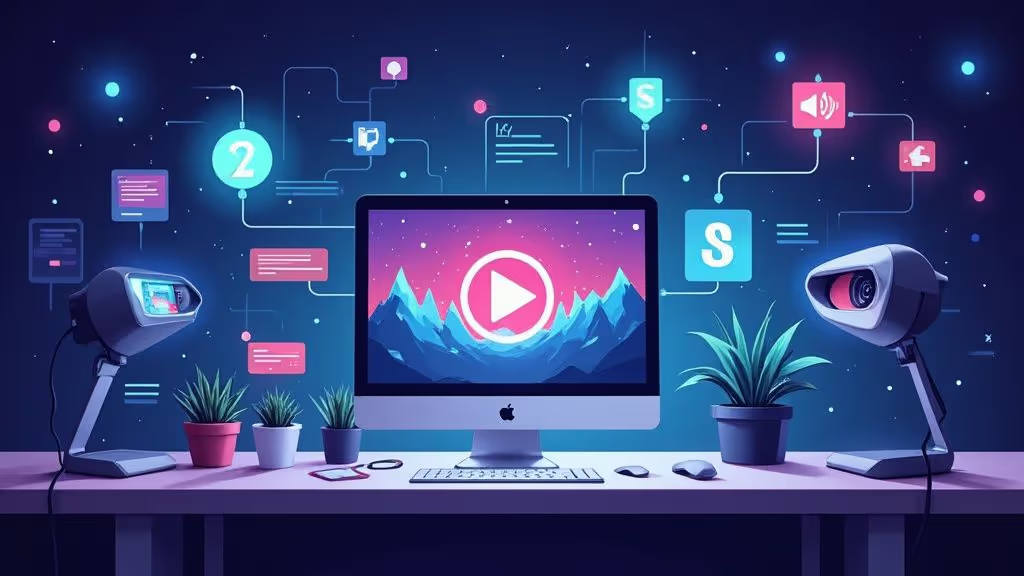Table of Contents
The Truth About VSLs: Beyond Standard Video Marketing

What exactly is a VSL in marketing? The term is often used alongside other types of video content, which can be confusing. A Video Sales Letter (VSL) is different from a typical explainer video or social media clip. It's a carefully structured, direct-response marketing tool with one primary goal: conversion. This means every element, from the script to the visuals, is strategically designed to persuade viewers to take a specific action, such as buying a product or registering for a webinar.
So, where did these powerful sales tools originate? VSLs evolved from traditional sales letters, those long-form, text-based pitches created to sell products directly. These letters depended on persuasive writing and a strong understanding of consumer psychology. VSLs bring this foundation into the digital age, using the engaging power of video to amplify their persuasive impact.
This shift to video makes sense in our visually-driven world. VSLs utilize sight, sound, and motion to connect with viewers on a deeper level. Think of it this way: a text-based sales letter is like reading a restaurant menu, while a VSL is like savoring the meal itself. This immersive experience allows VSLs to build rapport, overcome objections, and drive action more effectively than text alone.
Why VSLs Matter in Modern Marketing
While traditional sales letters might seem like relics of the past, the core principles remain relevant. VSLs adapt these principles for today's consumers, grabbing attention in a content-saturated world. They accomplish this by understanding the psychology of persuasion.
Effective VSLs use storytelling, social proof, and emotional appeals to build trust and create a sense of urgency. This isn't about fancy visuals for their own sake; it's about crafting a narrative that connects with the viewer's needs and desires. This focused approach is why smart marketers use VSLs at key conversion points in their sales funnels.
VSLs are especially effective for high-value products or services that require detailed explanations and strong value propositions. What's more, VSLs are incredibly adaptable, working across various platforms and formats while maintaining their core focus on conversion. Additionally, value selling is central to VSL effectiveness. Often represented as VSL (Value Selling Letter or Video Sales Letter) in marketing, value selling emphasizes the benefits a product or service brings to the customer, rather than just features or price. Companies using value-based selling often see improved buyer engagement and conversion rates. Learn more about value selling
Anatomy of High-Converting VSLs That Actually Work

Understanding the concept of a Video Sales Letter (VSL) is just the beginning. To truly harness its potential, you need to grasp the elements of a high-converting VSL. These aren't simply videos; they're precisely designed sales mechanisms built on structural components and psychological cues.
The Power of a Structured Narrative
Effective VSLs adhere to a clear narrative structure, guiding the viewer toward a desired action. This framework isn't random; it's rooted in proven sales techniques adapted for video. Think of it as a compelling story with a beginning, rising action, climax, and resolution.
- The Hook: The opening seconds are crucial. A strong hook—a startling statistic, a relatable problem, or an engaging visual—captures attention and sets the stage.
- Problem Identification: Successful VSLs pinpoint the viewer's pain points, addressing frustrations and challenges to build empathy and understanding.
- Solution Presentation: Here, your product or service emerges as the solution. The VSL demonstrates how it solves problems and fulfills needs, showcasing tangible benefits, not just features.
- Building Credibility: Testimonials, case studies, and data build trust. This social proof validates your solution and reassures potential customers.
- The Compelling Call to Action: The VSL concludes with a clear call to action, instructing viewers on the next step, whether it's clicking a button, visiting a website, or making a call. This element is essential for maximizing conversions.
Authenticity and Persuasion: A Delicate Balance
While persuasion is the goal, it must be grounded in authenticity. Viewers can easily detect a contrived pitch. Successful VSLs balance promotion with genuine connection, requiring:
- Understanding Your Audience: Thorough research allows you to address the specific needs and aspirations of your target audience.
- Storytelling: Integrating your product into a relatable story makes the message more engaging and memorable.
- Transparency: Openly addressing your product's limitations enhances trust and credibility.
To understand the core components of a successful VSL in greater detail, let's look at the following table:
Essential Elements of High-Converting VSLs
A breakdown of the key components found in successful Video Sales Letters and their purpose in the conversion process
As you can see, each element plays a critical role in moving the viewer through the sales funnel. From the initial hook to the final call to action, a well-crafted VSL guides the audience towards a purchase decision.
Why VSLs Outperform Traditional Marketing Approaches

What makes a Video Sales Letter (VSL) so effective? It's the ability to connect with viewers on a deeper level than traditional marketing often achieves. A VSL isn't just a video; it's a strategically crafted message designed to resonate with your audience and drive conversions. This section explores the distinct advantages of VSLs and how they leverage the power of visuals and storytelling to achieve remarkable results.
The Neuroscience of Engagement
Think about the difference between reading a product description and watching a product demonstration. Our brains are wired to process visual information more efficiently than text. VSLs capitalize on this inherent preference, resulting in higher retention rates and deeper engagement. The combined impact of visuals and audio creates an immersive experience, making the message more memorable and impactful. This enhanced recall translates to increased brand recognition and a greater likelihood of purchase.
Comparing VSLs to Other Methods
How do VSLs stack up against other common marketing approaches? Let's take a look:
- Webinars: While valuable for providing in-depth information, webinars can be lengthy and require a significant time investment from the viewer. This can lead to lower completion rates compared to the concise and focused nature of a VSL.
- Static Sales Pages: These lack the dynamic engagement of video, making it harder to capture and maintain attention. Conveying complex information or building an emotional connection is also a challenge with static content.
- Social Media Ads: The short, fragmented nature of social media makes it difficult to deliver a comprehensive sales message. Social media ads can be effective for generating initial interest but often fall short in converting prospects into paying customers.
- Email Sequences: Email is essential for nurturing leads, but lengthy text-based sales pitches can be overwhelming. Integrating VSLs into email campaigns can dramatically improve the delivery of your core sales message and boost engagement.
To illustrate the key differences between VSLs and other marketing formats, let's examine the following comparison table:
VSLs vs. Other Marketing Formats
Comparison of Video Sales Letters against other popular marketing methods across key performance metrics
This table highlights the strengths of VSLs in terms of engagement and conversion, especially when compared to static or text-heavy formats. While production costs can be higher, the potential return on investment makes VSLs a compelling option for businesses looking to boost their sales.
Integrating VSLs for Maximum Impact
VSLs are not meant to replace all other marketing efforts; they work best as part of a larger strategy. For example, a video production agency like Get Camera Crew might use short social media clips to pique interest, then direct viewers to a landing page featuring a compelling VSL. This integrated approach leverages the strengths of multiple channels for optimal results. Strategically positioning VSLs within a broader marketing ecosystem allows businesses to maximize their conversion potential and drive substantial growth.
Crafting VSL Scripts That Convert Skeptics into Buyers

The script is the bedrock of any successful Video Sales Letter (VSL). It serves as the blueprint that directs the viewer's experience, taking them from initial interest to a final purchase. A truly effective VSL script doesn't simply relay facts; it weaves a narrative, addresses customer pain points, and offers solutions that resonate deeply with the target audience. This section explores the art of writing VSL scripts that transform skeptical viewers into enthusiastic customers.
Understanding Your Audience: The First Step to Persuasion
Before putting pen to paper, or fingers to keyboard, experienced copywriters dedicate time to understanding their intended audience. This involves digging into demographics, psychographics, and online behavior. They seek to answer crucial questions. What are their most pressing problems? What are they hoping to achieve? What kind of language resonates with them? This knowledge forms the foundation of a script that speaks directly to the viewer's needs and aspirations.
Practical Techniques for Maintaining Viewer Attention
Holding viewer attention throughout a longer presentation requires careful planning and skillful execution.
- Vary the Visuals: Employ a diverse mix of video footage, graphics, and on-screen text to prevent visual fatigue and keep things interesting.
- Incorporate Storytelling: Weaving your product or service into a relatable story makes the message more captivating and easier to remember.
- Use Pacing and Rhythm: Modulate the tempo of your script and visuals to maintain viewer interest and prevent their attention from wandering.
This approach also helps cultivate stronger buyer-seller relationships.
Presenting Your Offer: Creating Urgency Without Being Pushy
Generating a sense of urgency is vital for driving conversions, but it needs to be done authentically. Rather than resorting to high-pressure tactics, concentrate on limited-time offers, exclusive bonuses, or emphasizing the potential drawbacks of inaction. This encourages viewers to make a purchase decision without feeling pressured. A well-crafted VSL doesn't simply sell a product; it guides the viewer toward a decision that ultimately benefits them.
Production Strategies: From Script to Finished VSL
Creating a compelling Video Sales Letter (VSL) takes more than just a well-written script. The production process itself has a significant impact on viewer engagement and, ultimately, conversions. This section explores how to transform your script into a polished VSL, covering production methods for budgets ranging from DIY setups to professional studios.
Production Approaches: Balancing Quality and Budget
Several approaches exist for VSL production, each with its own advantages and disadvantages:
- DIY Production: Perfect for businesses on a tight budget, this method utilizes readily available resources such as smartphones and basic video editing software like Camtasia. Prioritize clear audio and good lighting. This approach demands resourcefulness but can be remarkably effective with thorough planning.
- Freelance Collaboration: Hiring freelance videographers, editors, and animators provides a good balance of quality and affordability.
- Professional Studio Production: This premium option offers the highest quality but carries a significant cost. Consider this route for key products that demand a polished, professional appearance.
Optimizing Visual and Audio Elements
Keeping viewers engaged requires visual variety. Combine footage, graphics, on-screen text, and animation to craft a dynamic experience. However, avoid overwhelming viewers with excessive visuals. Strive for balance to ensure your core message stays clear.
High-quality audio is equally crucial. Poor audio can quickly deter viewers. Invest in a decent microphone and maintain clear, consistent sound throughout your VSL. This attention to detail elevates the entire viewer experience.
Software and Equipment: Essential Tools for VSL Production
Choosing the right software and equipment is vital for creating VSLs efficiently and effectively. Keep these factors in mind:
- Video Editing Software: Beginner-friendly options like Camtasia are a great starting point, while Adobe Premiere Pro provides more advanced features for complex projects. The best software depends on your budget and editing skills.
- Audio Equipment: A quality microphone significantly enhances audio clarity. Consider lavalier microphones for interviews and condenser microphones for voiceovers. Crisp, clear audio is essential for audience engagement.
- Lighting and Visuals: Even minor lighting improvements can dramatically enhance your VSL's visual appeal. Maximize natural light and consider investing in basic lighting equipment for indoor filming.
Testing and Optimizing: Making Good VSLs Great
Creating a Video Sales Letter (VSL) is just the first step. The real magic happens in the optimization process. This is where a good VSL transforms into a high-converting machine. Let's explore how conversion specialists identify the most impactful elements for testing and how they use viewer data to refine their VSLs for maximum results.
Establishing Baseline Metrics: Knowing Your Starting Point
Before changing anything, it’s essential to understand your VSL’s current performance. This means tracking key metrics like view counts, watch time, click-through rates, and, of course, conversion rates. These metrics provide a benchmark to measure the impact of future optimizations. It's like setting the zero point on a scale – you need a starting point to measure any change accurately.
Tracking Viewer Behavior: Uncovering Hidden Insights
Tracking viewer behavior provides granular data that goes beyond simple view counts. Knowing where viewers drop off during your VSL can pinpoint areas needing improvement. Is a particular section too long? Is it confusing? Or is it simply not engaging enough? This data provides actionable insights to guide optimization efforts and focus energy where it matters most.
Interpreting Drop-Off Points: Identifying Areas for Improvement
Analyzing drop-off points identifies specific weaknesses in your VSL. A high drop-off rate early in the video could signal a weak hook. A drop-off just before the call to action might suggest issues with the offer or its presentation. Understanding these patterns allows for informed decisions about what to change, taking the guesswork out of improvements.
A/B Testing: The Scientific Method for VSL Optimization
A/B testing is a powerful optimization technique. It involves creating two slightly different versions of your VSL and showing each version to a segment of your audience. Comparing the performance of each version pinpoints the most effective elements. Even small changes, like rewording the call to action or changing the background music, can significantly impact conversion rates.
Adapting for Different Audiences and Traffic Sources
A successful VSL with one audience may not work for another. Tailor your VSL to different segments of your target market. This might mean adjusting the messaging, visuals, or video length. Similarly, adapt your VSL based on its traffic source. A VSL for a paid advertising campaign requires a different approach than one embedded on a product landing page. Understanding your audience and their viewing context allows for refined messaging and optimal impact.
Measuring What Matters: VSL Performance Metrics
Beyond simple view counts, what truly reveals your Video Sales Letter (VSL)'s success? This section explores the Key Performance Indicators (KPIs) that correlate with revenue, shifting the focus from vanity metrics to those that truly drive business growth.
Beyond Vanity Metrics: Focusing on Engagement
While views offer a starting point, they only scratch the surface. True VSL performance hinges on engagement, analyzing metrics that signify genuine interest and a propensity to purchase.
- Watch Time: How much of your VSL are viewers actually watching? A high drop-off rate early on suggests a weak opening or content that misses the mark. High watch time, particularly towards the end, indicates genuine interest in your offer.
- Click-Through Rate (CTR): How many viewers click on your call to action? This metric directly reflects the effectiveness of your offer and how compellingly it's presented in the VSL.
- Engagement Actions: Are viewers liking, commenting, or sharing your VSL? These actions signify active participation and positive reception, indicating potential for broader organic reach.
For example, a VSL with millions of views but low watch time and CTR signals a disconnect between the content and the target audience. Conversely, a VSL with fewer views but high engagement and CTR often suggests a more focused and effective strategy.
Attribution and the Bigger Picture
VSLs seldom operate in isolation. They often function within a broader marketing funnel, making accurate attribution essential. This involves precisely tracking which conversions stem from your VSL, even if the purchase happens later or via a different channel. This clarity is vital for calculating ROI accurately and understanding the true impact of your VSL within your overall marketing plan. For instance, if a viewer watches your VSL and later purchases through an email link, that conversion should still be attributed to the VSL.
Metrics That Mislead: Avoiding False Positives
Certain metrics can be deceiving. A high number of shares, for example, might seem positive. However, if those shares don't translate into conversions, they may indicate a disconnect between the content's shareability and its ability to drive sales. Similarly, fixating solely on short-term conversions can obscure the long-term value of customers acquired through a VSL. Consider metrics like customer lifetime value and repeat purchase rates to grasp the full impact of your VSL on revenue generation.
Calculating ROI: The True Measure of Success
Calculating VSL Return on Investment (ROI) requires considering both immediate conversions and the downstream value of acquired customers. This entails factoring in the production costs of your VSL and comparing them to the revenue generated, both directly and indirectly, through customer acquisition and retention. This comprehensive approach provides a more accurate assessment of your VSL's financial performance.
Benchmarking and Scaling Success
Benchmark your results against industry standards to understand how your VSL performs relative to competitors. This provides valuable context for your metrics and highlights areas for potential improvement. Once you have a successful VSL, adapt and scale it for various audience segments or product offerings. This might involve creating versions of your VSL with tailored messaging or visuals to maximize its impact across different markets.
By focusing on these key metrics and avoiding the trap of vanity metrics, you can gain a true understanding of your VSL's performance and optimize it for maximum results. This data-driven approach ensures your VSL not only captures attention but also delivers meaningful outcomes for your business. Ready to create compelling VSLs that convert? Get Camera Crew, a leading video production agency, specializes in producing high-quality video content for corporate brands worldwide. Visit their website to learn more about their services and help you with VSL production.



.jpg)


